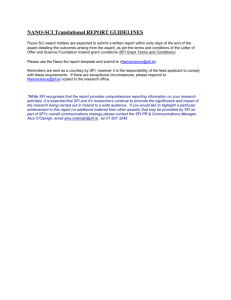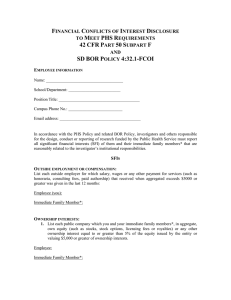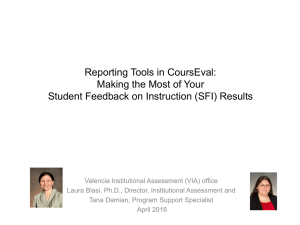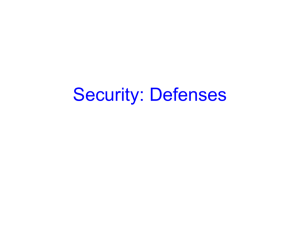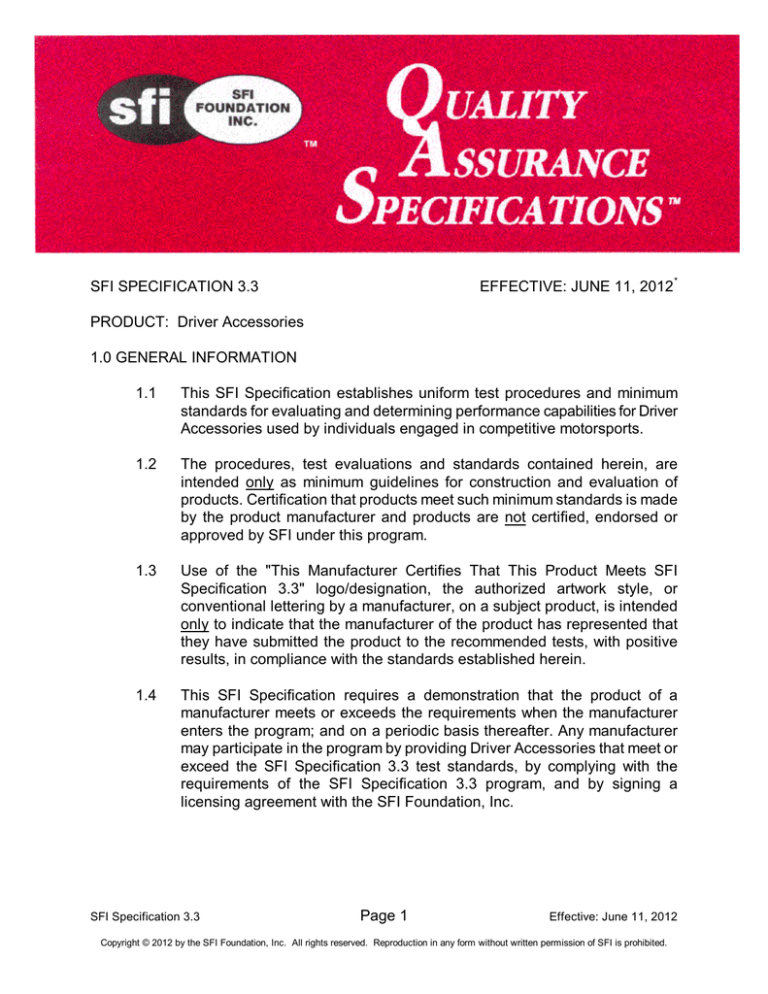
EFFECTIVE: JUNE 11, 2012 *
SFI SPECIFICATION 3.3
PRODUCT: Driver Accessories
1.0 GENERAL INFORMATION
1.1
This SFI Specification establishes uniform test procedures and minimum
standards for evaluating and determining performance capabilities for Driver
Accessories used by individuals engaged in competitive motorsports.
1.2
The procedures, test evaluations and standards contained herein, are
intended only as minimum guidelines for construction and evaluation of
products. Certification that products meet such minimum standards is made
by the product manufacturer and products are not certified, endorsed or
approved by SFI under this program.
1.3
Use of the "This Manufacturer Certifies That This Product Meets SFI
Specification 3.3" logo/designation, the authorized artwork style, or
conventional lettering by a manufacturer, on a subject product, is intended
only to indicate that the manufacturer of the product has represented that
they have submitted the product to the recommended tests, with positive
results, in compliance with the standards established herein.
1.4
This SFI Specification requires a demonstration that the product of a
manufacturer meets or exceeds the requirements when the manufacturer
enters the program; and on a periodic basis thereafter. Any manufacturer
may participate in the program by providing Driver Accessories that meet or
exceed the SFI Specification 3.3 test standards, by complying with the
requirements of the SFI Specification 3.3 program, and by signing a
licensing agreement with the SFI Foundation, Inc.
SFI Specification 3.3
Page 1
Effective: June 11, 2012
Copyright © 2012 by the SFI Foundation, Inc. All rights reserved. Reproduction in any form without written permission of SFI is prohibited.
1.5
Compliance with this specification is entirely voluntary. However, when a
manufacturer provides Driver Accessories in compliance with all
requirements of the SFI Specification 3.3 and enters into the licensing
agreement with the SFI Foundation, Inc., they may certify that compliance
with such standards is in accordance with the guidelines established herein.
1.6
Manufacturers wishing to participate in the program, in addition to the other
requirements of this specification, must label each of their products with the
manufacturer's name, trademark or symbol as well as the date of
manufacture of the product.
1.7
No manufacturer may display the SFI logo/designation on their product
unless the manufacturer has signed a licensing agreement with SFI and has
successfully complied with all the requirements of this specification and the
self-certification program.
2.0 DEFINITIONS
2.1
Driver Accessories: The various items that complement a driver's suit to
protect the wearer. This specification covers gloves, underclothing, hoods,
socks, shoes, boots, helmet supports, harness pads, arm restraints, helmet
skirts, and sports bras.
2.2
Layers: Accessory material can be constructed of a single layer or multiple
layers of fabric. An accessory's suitability or rating is based on the thermal
protection capability of the material regardless of the number of layers.
2.3
After-flame time: The time an object continues to flame after the thermal load
is removed.
2.4
FTM 191-1534: Federal Test Methods, Standard 191A, Textile Test
Methods, Method 5134; Melting Point of Synthetic Fibers.
2.5
Any Driver Accessory pertaining to this specification shall remain as
constructed by the original manufacturer and shall not be modified or altered
by anyone else.
3.0 CONSTRUCTION
All accessories shall be made of fire resistant/retardant material except where noted. The
weave of the material shall be continuous with no breaks, holes or separations except
where necessary to provide functionality. Thread used for accessory construction shall be
made of fire resistant/retardant material.
SFI Specification 3.3
Page 2
Effective: June 11, 2012
Copyright © 2012 by the SFI Foundation, Inc. All rights reserved. Reproduction in any form without written permission of SFI is prohibited.
3.1 GLOVES
Gloves shall have separate sections for each finger and thumb. The upper and
lower halves of the glove may be constructed differently. Gloves may also be
composed of a separate top covering, a separate bottom covering and separate
coverings for the areas on the sides of the fingers (also called forchettes), all being
of different construction. If a fastening mechanism is used, the mechanism is not
required to be made of fire resistant/retardant material. On all gloves, the bottom
covering and forchettes, if applicable, may not be made entirely of leather and must
have a layer of material (which the manufacturer represents to be fire
resistant/retardant) separating any leather from the driver's hand and it is not
required to be tested. Gloves shall be rated by the amount of thermal protection
provided by the material used. Sections shall be sewn together.
3.2 UNDERCLOTHING
Underclothing shall cover the body from the neck to the ankles and wrists. The
garment shall be snugly fitting at the neck, ankles and wrists. It can be a one-piece
garment or a two-piece, consisting of a top and pants.
3.3 HOODS
Hoods shall be snugly fitting at the neck and include a bib that extends at least six
(6) inches (15.2cm) below the chin. There shall either be a single oval opening for
both eyes or dual, individual circular openings for each eye.
3.4 SOCKS
Socks shall extend up the leg and should overlap with the underclothing and/or
driver suit.
3.5 SHOES AND BOOTS
Shoes and boots shall incorporate fire resistant/retardant material in the non-sole
area. Other materials may be used providing they do not inhibit the protective
capability of the assembly. Shoes shall have a standard configuration. Boots shall
extend up the leg at least six (6) inches (15.2cm). This dimension shall be taken at
the rear of the boot, measured from the bottom of the sole to the top of the
extension.
SFI Specification 3.3
Page 3
Effective: June 11, 2012
Copyright © 2012 by the SFI Foundation, Inc. All rights reserved. Reproduction in any form without written permission of SFI is prohibited.
3.6 HELMET SUPPORT
Helmet supports (also called neck braces and neck supports) shall have a fire
resistant/retardant material covering. The padding or core material shall also be fire
resistant/retardant. Helmet supports shall encircle the entire neck; 360 degrees.
They shall have a break in the front or side and a device to fasten the ends
together.
3.7 HARNESS PADS
Harness pads shall have a fire resistant/retardant material covering. The padding or
core material shall also be fire resistant/retardant. The configuration shall either be
a "U" shape with the opening in front and have provisions for the belts to slip
through or they can be individual pads for each belt strap.
3.8 ARM RESTRAINTS
Arm restraints are not required to be made from fire resistant/retardant material.
They shall be mounted on one end to the driver restraint lap belt and the other end
to the arm or wrist. The minimum width for the portion of the arm restraint that wraps
around the arm or wrist shall be 1 3/4 inches (4.4 cm) minimum. The lap belt end
shall be mounted in such a manner as to prevent the arm from traveling outside of
the driver's compartment. Each arm may have a separate strap or the restraint may
have a "Y" configuration, with only one attachment to the lap belt. Any loose
webbing end shall incorporate a design method to prevent the strap from
completely pulling out of any hardware (d-rings, 3-bar slide, etc.) Examples of
possible methods are shown below:
Loose Strap End is
Rolled or Folded and
Sewn in Place
SFI Specification 3.3
Loose Strap End is Rolled
Around Dowel (plastic, foam,
etc.) and Sewn in Place
Page 4
Effective: June 11, 2012
Copyright © 2012 by the SFI Foundation, Inc. All rights reserved. Reproduction in any form without written permission of SFI is prohibited.
3.9 HELMET SKIRT
Helmet skirts shall be constructed of fire resistant material and shall encircle the
entire neck (360 degrees). Helmet Skirts that are used for drag racing shall be a
minimum of eight (8) inches in length. Helmet skirts may be glued or sewn to the
helmet lining, or may be attached to the inside or outside of the helmet with hook
and loop closure. Any hook and loop closure must be of fire resistant material.
3.10 SPORTS BRA
Sports bras shall be constructed of fire resistant material. There shall be no wire,
metal, or plastic construction.
4.0 MODEL CLASSIFICATION
Driver Accessory models are based on materials and construction. Any variation shall be
considered a model change.
5.0 TESTING
5.1 TPP RATING
All accessories listed shall be subjected to this test. The test shall be conducted in
accordance with SFI Technical Bulletin 3.2.
5.1.1 SAMPLES
The sample material shall be a representation of the actual accessory as
stated in the technical bulletin. Three samples of each particular material
shall be tested. If any material/construction combination of one accessory is
identical to another, then only one need be tested. The samples may be a
representation of the actual accessory if they comprise the identical material
and construction method.
A. GLOVES
A set of samples shall be tested for the top covering or half, the
bottom covering or half and the forchettes, if applicable.
B. UNDERCLOTHING
If the underclothing consists of two pieces and both are made of
identical material and construction, then either one may be tested.
Otherwise, each piece shall be tested separately.
SFI Specification 3.3
Page 5
Effective: June 11, 2012
Copyright © 2012 by the SFI Foundation, Inc. All rights reserved. Reproduction in any form without written permission of SFI is prohibited.
C. HOODS AND SOCKS
The samples may be taken from any portion of the accessory.
D. SHOES AND BOOTS
The samples shall be material from the non-sole portion of the shoe
or boot.
E. HELMET SUPPORTS AND HARNESS PADS
The samples shall be taken from the outer covering of the accessory,
not including belt containment material, if applicable.
F. HELMET SKIRT
The samples may be taken from any portion of the accessory.
G. SPORTS BRA
The samples may be taken from any portion of the accessory.
5.2 FLAMMABILITY, FABRIC
All accessories that are required to undergo the TPP test shall be subjected to this
test. The test shall be conducted in accordance with SFI 3.2 Technical Bulletin.
5.2.1 SAMPLES
The samples shall be provided as stated above in the previous section. If the
accessory material consists of multiple layers, then only the outer layer is
required to be tested, except for Underclothing, Hoods, Socks, Helmet Skirts,
and Sports Bras, in which each different material layer shall be tested.
However, if any non-fabric material such as leather is used as the outer layer
of gloves or the soles of shoes, that material shall not be required to pass
the flammability test.
5.3 FLAMMABILITY, PADDING MATERIAL
This test shall only be conducted on the padding material in helmet supports and
harness pads. The test shall be conducted at an ambient temperature between
10˚C (50˚F) and 30˚C (86˚F).
SFI Specification 3.3
Page 6
Effective: June 11, 2012
Copyright © 2012 by the SFI Foundation, Inc. All rights reserved. Reproduction in any form without written permission of SFI is prohibited.
5.3.1 SAMPLES
Test sample shall be padding material from one (1) fully processed new
harness pads or helmet supports with the outer covering removed, which is
representative of harness pads or helmet supports currently produced or to
be produced.
5.3.2 APPARATUS
A. THERMAL LOAD
The thermal load shall be a Bunsen or Tirrill type burner with tube
length of 3.75 ± 0.25 inches and inside diameter of 0.375 +0.06/-0.00
inch, at the flame location generating a measured temperature of
1550˚F.
B. TIMING DEVICE
A timing device with an accuracy of +
_0.5 seconds shall be used to
measure the after-flame times.
C. FIXTURE
A fixture shall be used to support the padding sample.
5.3.3 PROCEDURE
The flame shall be adjusted to 1.5” in length and positioned perpendicular to
the padding surface. The padding surface shall be subjected to the thermal
load for a period of 15 ±1 seconds at a distance of 1” to 1.5" (surface of
padding to flame tip). Simultaneous with the removal of the flame, the timing
device shall be activated. Determine the after-flame time.
5.4 FLAMMABILITY, GLOVE SEAMS
This test shall only be conducted on the construction seams of the fingers of gloves.
This test shall be conducted in accordance with SFI 3.2 Technical Bulletin
Flammability Test, with the following modifications.
5.4.1 SAMPLES
Test sample shall be one (1) fully processed new glove which is
representative of gloves currently produced or to be produced.
SFI Specification 3.3
Page 7
Effective: June 11, 2012
Copyright © 2012 by the SFI Foundation, Inc. All rights reserved. Reproduction in any form without written permission of SFI is prohibited.
5.4.2 PROCEDURE
A. Each finger and thumb to be tested shall be isolated from the other fingers
of the glove by folding and securing the other fingers away from the gas
burner.
B. The finger shall be filled with a metal rod. The diameter of the rod shall
simulate the diameter of the finger of the wearer of the glove. The end of the
rod shall be rounded.
C. The top of the finger shall be in contact with the flame.
D. Determine the afterflame time only.
E. For each test, note the condition of the seam and materials around the
seam.
F. Repeat the test procedure for each finger and thumb on the sample glove.
5.5 THREAD HEAT RESISTANCE
All accessories that are required to undergo the TPP test shall be subjected to this
test. The test shall be conducted in accordance with FTM 191-1534 unless
otherwise specified.
5.5.1 SAMPLES
The sample material shall be identical to the thread used in the actual
construction of the accessory. Sufficient material for at least three tests shall
be supplied.
5.5.2 PRECONDITIONING
Samples shall be conditioned at a temperature of 21 ±1 degrees Celsius {°C}
(70 ±2 degrees Fahrenheit {°F}) at a relative humidity of 65 ±5 percent for
one hour. Samples shall be tested not more than five minutes after removal
from conditioning.
5.5.3 PROCEDURE
Conduct the test three times. The samples shall be tested to a temperature
of 260 ±2°C (500 ±4°F).
SFI Specification 3.3
Page 8
Effective: June 11, 2012
Copyright © 2012 by the SFI Foundation, Inc. All rights reserved. Reproduction in any form without written permission of SFI is prohibited.
5.5.4 INTERPRET RESULTS
For each sample, determine its condition at the specified temperature.
5.6 TENSILE STRENGTH
This test shall only be conducted on arm restraints. Each configuration shall be
tested. If the straps are separate, two restraints shall be tested. For a "Y"
configuration, only one need be tested.
5.6.1 SAMPLES
Test samples shall be fully processed new arm restraints which are
representative of arm restraints currently produced or to be produced. All
necessary mounting hardware along with mounting instructions shall be
supplied with the arm restraint.
5.6.2 APPARATUS
A. TEST MACHINE
The test machine shall be capable of applying a minimum tensile load
of 400 pounds {lb} (1779.2 newtons {N}) with an excursion travel of
four (4) to ten (10) inches per minute {ipm} (10.2 to 25.4 centimeters
per minute {cmpm}), and shall have adequate instrumentation to
verify the test load. The test machine shall also be in calibration and
traceable to the National Institute of Standards and Technology
(NIST).
B. TEST FIXTURE
The test fixture shall duplicate the mounting method of the arm
restraint on both ends and be capable of withstanding the applied
load. A cylinder with the approximate diameter shall be used to
simulate the arm or wrist.
SFI Specification 3.3
Page 9
Effective: June 11, 2012
Copyright © 2012 by the SFI Foundation, Inc. All rights reserved. Reproduction in any form without written permission of SFI is prohibited.
5.6.3 PROCEDURES
A.
In one head of the test machine, mount the fixture to simulate
the lap belt. Connect the corresponding end of the restraint to
the fixture. Connect the other end to the solid cylinder, which
shall be fixed to the other head. If the restraint uses a "Y"
configuration, mount only one of the arm straps to the cylinder.
If the strap has a connection device and/or adjustment
hardware, connect and adjust per manufacturer's instructions.
The strap, strap hardware and heads shall be in axial
alignment.
B.
Using an excursion rate of twenty (20) ipm (50.8cmpm), apply
an increasing load to the restraint device. Continue until a load
of 400 +10/-0 lb (1779.2 +44.5/-0 N) is applied. Hold at that
level for ten seconds, then release the load.
C.
If the "Y" configuration is used, repeat the procedure for the
other arm strap.
6.0 PROOF OF COMPLIANCE
Driver Accessory manufacturers are required to provide the following information to enroll
in this program:
6.1 TEST RESULTS
Test results shall be documented in a test report.
6.1.1 TPP RATING
An accessory shall be evaluated by the rating received when tested in
accordance with SFI Technical Bulletin 3.2.
A. GLOVES
A Glove shall be classified by the TPP rating of the top covering or
half, as represented by the material tested. The material shall be
considered to have passed the TPP test if it qualifies for an SFI grade
as delineated in Table 1. In order to fulfill the requirements for a given
grade, the other portions of the glove, if applicable, must satisfy the
following requirements, as represented by the material tested. The
bottom covering or half, as represented by the material tested, shall
have a TPP rating equal to or greater than 40 percent of the value
SFI Specification 3.3
Page 10
Effective: June 11, 2012
Copyright © 2012 by the SFI Foundation, Inc. All rights reserved. Reproduction in any form without written permission of SFI is prohibited.
required for the top or meet the requirements for SFI grade 1,
whichever is greater. The forchettes, as represented by the material
tested, shall have a TPP rating equal to or greater than 20 percent of
the value required for the top or meet the requirements for SFI grade
1, whichever is greater. A glove not able to meet this criteria shall be
downgraded to a level where all sections conform to the required
values. For grade 1, only the top covering or half, as represented by
the material tested, is required to pass the TPP requirements.
Abbreviations used: calories {cal}, centimeters {cm}, watts {W},
seconds {sec} and not applicable {na}.
Table 1
SFI
Grade
Top
Cal/cm2
W-sec/cm2
TPP Rating
Bottom
Cal/cm2
W-sec/cm2
Forchettes
Cal/cm2
W-sec/cm2
1
> 6
> 25.1
NA
NA
NA
NA
5
> 19
_
> 79.6
_
> 7.6
_
> 31.8
_
> 6.0
_
> 25.1
_
10
> 38
_
> 159.1
_
> 15.2
_
> 63.6
_
> 7.6
_
> 31.8
_
15
> 60
_
> 251.2
_
> 24.0
_
> 100.5
_
> 12.0
_
> 50.2
_
20
> 80
_
> 335.0
_
> 32.0
_
> 134.0
_
> 16.0
_
> 67.0
_
25
> 100
_
> 418.7
_
> 40.0
_
> 167.5
_
> 20.0
_
> 83.7
_
30
> 120
_
> 502.4
_
> 48.0
_
> 201.0
_
> 24.0
_
> 100.5
_
B. UNDERCLOTHING, HOODS, SOCKS, HELMET SUPPORTS
HARNESS PADS AND SPORTS BRAS
Underclothing, hoods, socks, helmet supports, harness pads and
sports bras shall have a minimum TPP rating of 6.0 cal/cm2 (25.1 Wsec/cm2) to be acceptable, as represented by the material tested.
C. SHOES AND BOOTS
Shoes and boots shall have a minimum TPP rating of 19.0 cal/cm2
(79.6 W-sec/cm2) to be acceptable, as represented by the material
tested.
SFI Specification 3.3
Page 11
Effective: June 11, 2012
Copyright © 2012 by the SFI Foundation, Inc. All rights reserved. Reproduction in any form without written permission of SFI is prohibited.
D. HELMET SKIRT
A Helmet Skirt shall be classified by the TPP rating. The material
shall be considered to have passed the TPP test if it qualifies for an
SFI grade as delineated in Table 2.
Table 2
TPP Rating
SFI
Grade
Cal/cm2
W-sec/cm2
5
≥ 19
≥ 79.6
10
≥ 38
≥ 159.1
6.1.2 FLAMMABILITY, FABRIC
All accessories, as represented by the material tested in accordance with
SFI Technical Bulletin 3.2, shall be considered to have passed the
flammability test if each layer that is required to be tested passes the criteria
listed below.
A. INTERPRET RESULTS
The average after-flame time for all samples shall be 2.0 seconds or
less for the layer to pass. The average char length for the five
samples shall be six (6) inches (15.2cm) or less for the layer to pass.
Any melting or dripping of the material shall be cause for test failure.
6.1.3 FLAMMABILITY, PADDING MATERIAL
The after-flame time shall be ten seconds or less.
6.1.4 FLAMMABILITY, GLOVE SEAMS
The average after-flame time for all finger and thumb tests shall be 2.0
seconds or less. Also, any melting, dripping, or splitting of the seam or
material around the seam shall be cause for test failure.
6.1.5 THREAD HEAT RESISTANCE
At least two of the samples shall not melt, i.e. change from solid to liquid or
be consumed, at the test temperature.
SFI Specification 3.3
Page 12
Effective: June 11, 2012
Copyright © 2012 by the SFI Foundation, Inc. All rights reserved. Reproduction in any form without written permission of SFI is prohibited.
6.1.6 TENSILE STRENGTH
A. ARM RESTRAINTS
The arm restraints shall pass the tensile strength test if, for each strap
tested, it is able to maintain the test load for ten seconds.
7.0 TEST REPORTS
A separate test report, or set of test reports if required, shall be submitted for each product
model. If more than one test facility is required to complete all necessary tests, then a
separate test report shall be submitted from each one. A test report shall be submitted for
each component, if tested separately. The test facility shall assign a unique number to
each test report. This number along with the report date and page number shall appear on
each page. Each test report shall include:
7.1 RELEVANT INFORMATION
7.1.1 Manufacturer's name, contact name, address and telephone number.
7.1.2 Name, address and telephone number of the test facility.
7.1.3 Name and signature of the responsible test supervisor.
7.1.4 Actual date of the test.
7.1.5 Specification number and effective date.
7.1.6 Product name, description and model designation.
7.1.7 Component name and description.
7.2 TESTS
Each test conducted shall be listed showing the test name, apparatus used,
procedure used and test results obtained along with any other appropriate
information.
7.3 AUTHENTICATION
Test reports shall be authenticated and stamped by a Professional Engineer who is
registered in the state in which the testing is conducted. If necessary, SFI may allow
an equivalent entity to provide authentication.
SFI Specification 3.3
Page 13
Effective: June 11, 2012
Copyright © 2012 by the SFI Foundation, Inc. All rights reserved. Reproduction in any form without written permission of SFI is prohibited.
8.0 INITIAL DESIGN VALIDATION
To receive initial recognition from SFI as a participant in the SFI Specification 3.3 Program,
the manufacturer must submit to SFI all information delineated in the Proof of Compliance
section. This information shall be provided for each Driver Accessory model offered by the
applicant that is to be included in the program. Any change in design, materials and/or
methods of manufacturing not specifically excluded is considered a model change and,
therefore, requires initial design validation.
9.0 PERIODIC REVALIDATION
Test reports with successful test results must be submitted to SFI at least once every 24
month period following the date of the initial design validation test for driver accessories
manufactured by the participant. If multiple test reports are required to obtain all test
results, then the earliest test date shall be used to determine when the periodic
revalidation reports are due. Also, SFI shall retain the option to conduct random audit
reviews. SFI shall purchase the product on a commercial basis and test for compliance to
the specification. The submitting manufacturer shall reimburse SFI for all audit costs.
10.0 CERTIFICATION OF COMPLIANCE
Upon demonstration of successful compliance with all the requirements of the specification
and the self-certification program and upon entering the licensing agreement with SFI, the
manufacturer may advertise, present and offer the Driver Accessories for sale with the
representation that their product meets the SFI Specification 3.3. Continuing certification
is contingent upon the following additional considerations: (1) the product shall be
resubmitted for testing following any change in design, materials and/or methods of
manufacturing not specifically excluded, and (2) periodic revalidation test reports are
submitted when due to SFI.
11.0 CONFORMANCE LABELS
The conformance label is a patch. Each individual accessory shall have a patch attached
to the exterior surface. On gloves, the patch shall be on the upper cuff area of each glove.
On one-piece underclothing or the top of underclothing, the patch shall be sewed to the left
sleeve facing outward, between the elbow and the shoulder seam or corner. On pants, the
patch shall be sewed on the left side at the belt line. On hoods, the patch shall be sewed
on the outside lower bib area in the front. On socks, the patch shall be on the outside
surface above the ankle. On each individual shoe and boot, the patch shall be on an upper
outside surface. On helmet supports and one piece harness pads, the patch shall be on
the left extension, either on the top or outside surface. On individual harness pads, the
patch shall be placed on the upper outside surface. On arm restraints, one patch shall be
placed on each separate or detachable piece. On helmet skirts, one patch shall be placed
SFI Specification 3.3
Page 14
Effective: June 11, 2012
Copyright © 2012 by the SFI Foundation, Inc. All rights reserved. Reproduction in any form without written permission of SFI is prohibited.
on the lower front outside surface. On sports bras, one patch shall be placed on the
outside surface on the front or back of the sports bra.
12.0 DECERTIFICATION
Participating manufacturers are subject to decertification when not in compliance with the
requirements of this program or when their products are not in compliance with the
requirements of this specification. Decertification will provide SFI the right to effect any
and all remedies which are available to SFI in the licensing agreement.
13.0 APPEAL PROCEDURE
In the event of decertification, the manufacturer is entitled to an appeal of the decision of
SFI. Requests for appeal must be received by SFI no later than thirty days following
receipt of the notice of decertification. Appeals of such decisions will be heard at the next
meeting of the Board of Directors of SFI.
14.0 STATEMENT OF LIMITATIONS
Testing procedures and/or standards contained in this specification are intended for use
only as a guide in determining compliance with the minimum performance requirements as
defined herein. The granting and assignment of the "This Manufacturer Certifies That This
Product Meets SFI Specification 3.3" logo/designation is in no way an endorsement or
certification of product performance or reliability by SFI. SFI, its officers, directors and/or
members assume no responsibility, legal or otherwise, for failure or malfunctions of a
product under this program.
15.0 COSTS
All costs involved in this program will be absorbed by the submitting manufacturer.
16.0 COMPLIANCE PERIOD
As this specification is revised to reflect changes in technology and/or field conditions, to
remain current, participating manufacturers in the SFI Specification 3.3, Driver
Accessories, Program, must demonstrate full compliance with the requirements of this
specification within ninety (90) days of the latest effective date.
*
Original Issue:
Revised:
Revised:
Revised:
Reviewed:
SFI Specification 3.3
February 1, 1991
November 10, 1991
December 3, 1993
February 16, 1996
December 5, 1997
Page 15
Effective: June 11, 2012
Copyright © 2012 by the SFI Foundation, Inc. All rights reserved. Reproduction in any form without written permission of SFI is prohibited.
Edited:
Reviewed:
Revised:
Reviewed:
Reviewed:
Revised:
Reviewed:
Reviewed:
Revised:
Edited:
Revised:
Edited:
Reviewed:
Revised:
SFI Specification 3.3
January 15, 1998
November 18, 1999
November 29, 2001
December 4, 2003
December 1, 2005
October 11, 2006
December 6, 2007
December 10, 2009
May 21, 2010
June 2, 2010
December 31, 2010
January 11, 2011
December 1, 2011
June 11, 2012
Page 16
Effective: June 11, 2012
Copyright © 2012 by the SFI Foundation, Inc. All rights reserved. Reproduction in any form without written permission of SFI is prohibited.



